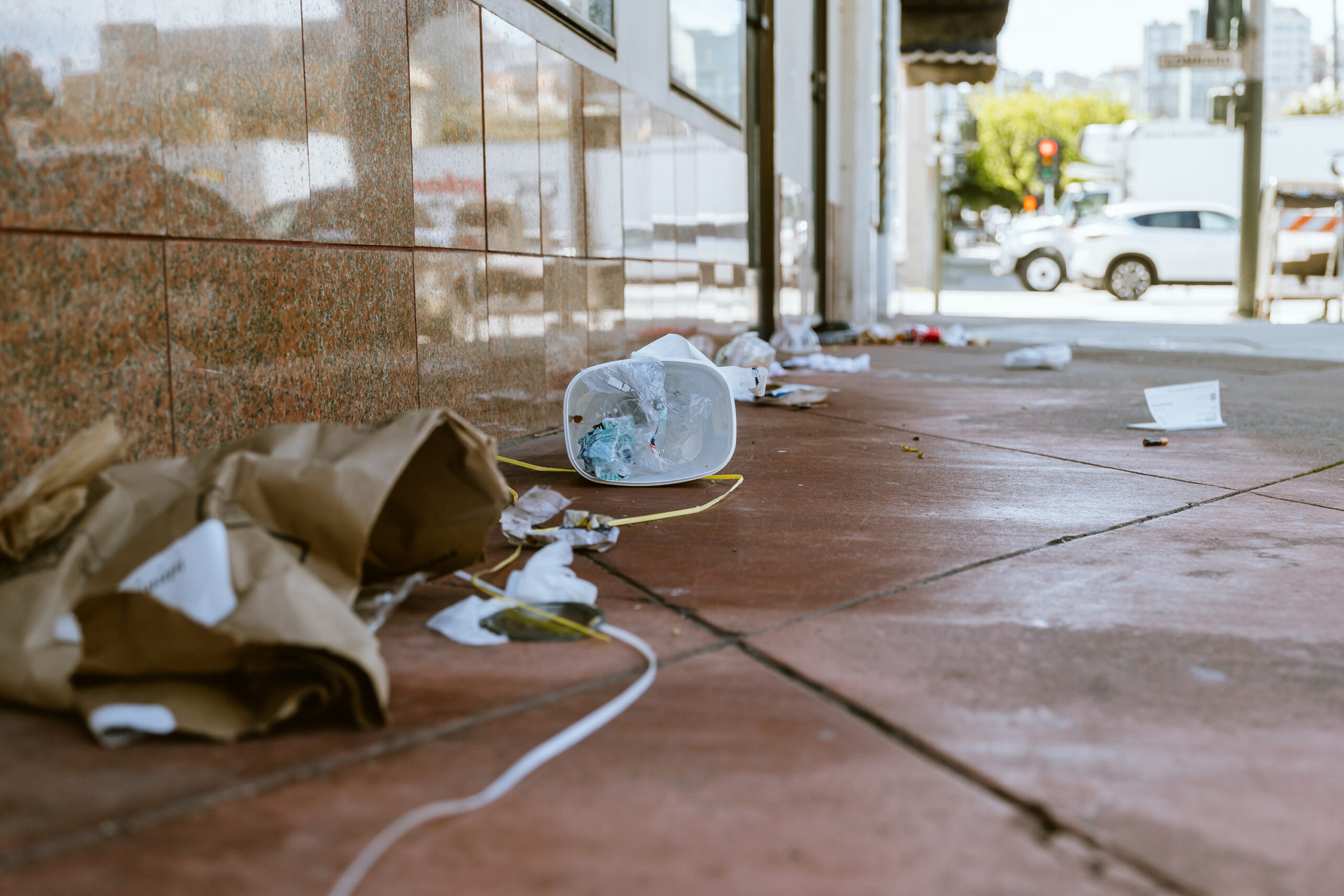Downtown San Francisco neighborhoods often make headlines for crime, drug use and seemingly endless big-box store closures. But the city’s wider problems with litter, feces lacquered on sidewalks and sightings of used syringes are sometimes overlooked.
San Francisco’s latest cleanliness survey shows the city’s streets are pretty dirty. But when you zoom in on individual neighborhoods, the story is a little different.
Titled “Street & Sidewalk Maintenance Standards,” the survey evaluated some 3,000 residential streets and commercial corridors for 2021-22, as ordered by the city services auditor. It found that commercial streets tended to fare worse on cleanliness and maintenance standards when compared with the rest of the city.
Each neighborhood has its own problems, however. Here’s how yours stacks up.
Mounds of Trash Dumped Illegally
The result? Dumping has become a huge problem in the city, as folks drop mounds of trash and large debris on sidewalks and known dumping hot spots—a practice that is free but also illegal, not to mention gross for anyone living in high-dumping zones.
Though the Bayview-Hunters Point neighborhood has been highlighted as a dumping hot spot, the Portola and Bernal Heights neighborhoods have taken the crown in 2022: Both neighborhoods reported illegal dumping activity in over 80% of their commercial area evaluations, compared with a citywide commercial areas rate of 36%.
The city says illegal dumping can make streets and sidewalks inaccessible and unsafe. This kind of activity includes construction debris, appliances, electronics, furniture, mattresses and bags of garbage.
Needles in Downtown San Francisco
Neighborhoods in San Francisco's Downtown reported the most amount of syringes on the streets. Surveyors found the most syringes, including full syringe barrels and needles, in the Tenderloin and South of Market neighborhoods. The areas are also the most affected by the drug crisis.
“Syringes on the streets and sidewalks of San Francisco are some of the most visible signs of open-air substance use,” the survey said. “Moreover, they pose a serious risk to public health and safety.”
Citywide, and especially in residential areas, it's much less common to see syringes on the sidewalks or streets. Just 1% of citywide checks found syringes, while a slightly higher share of commercial areas—3%—reported syringes. The chart represented the only neighborhoods with more than 0% of syringes reported.
More than half of evaluated neighborhoods didn’t find syringes, including the Financial District, Sunset, Mission Bay and Chinatown.
Experts say not to touch any syringes you find on the streets. Residents can report needles to the city’s 311 line or call the San Francisco AIDS Foundation’s hotline at 415-818-7769.
'San Francisco Snow'
Actual snow is rare in San Francisco, but broken glass is a common sight throughout the city—so much so that some merchants in Fisherman’s Wharf have dubbed broken glass as “San Francisco Snow.”
Broken glass is the most commonly observed hazard in SF, seen on roughly half of surveyed streets and sidewalks, according to the survey. Unsurprisingly, the surveys saw more glass in commercial areas than residential streets.
Of the neighborhoods with the largest number of evaluation surveys conducted, the Mission and SoMa observed broken glass in more than 70% of evaluations.
Feces on the Streets
Residents have long complained about wayward piles of poo pasted on San Francisco’s streets. The city’s survey validated these concerns, noting that nearly half of commercial streets had animal or human waste on them.
Nob Hill and the Tenderloin had the highest percentage of observed feces, and nine neighborhoods reported 50% of checks observing feces. Notably, observations included discarded baggies filled with feces, such as those your pooch might leave behind.
Some say the lack of available bathrooms might be to blame: The now-closed Whole Foods on Market Street blocked its restrooms to noncustomers last year, and many of the green JCDecaux kiosks that sometimes serve as public restrooms are perennially defunct. And staff at Downtown San Francisco’s Westfield mall say pooping in elevators is an increasingly common occurrence.
SF’s Most Tagged Neighborhood
Graffiti is a common sight throughout San Francisco, but especially in Haight-Ashbury, the birthplace of counterculture. Severe graffiti adorns the psychedelic neighborhood in more than 70% of observations, while bougier neighborhoods like the Marina or Noe Valley recorded few instances of graffiti.
But the issue is citywide, with 71% of key commercial areas reporting moderate to severe graffiti, according to survey evaluations. The issue has worsened in recent years: Graffiti complaints hit a 10-year high last summer, with the city’s 311 reporting program clocking over 1,300 of such complaints in July 2022 alone.
Property owners are legally responsible for clearing graffiti from their buildings, and the city may even fine residents if they don’t clean up tags fast enough. The city offers a Public Works abatement program that provides graffiti removal services to some SF commercial corridors.
Litter, Litter, Everywhere
It’s not uncommon to walk through San Francisco’s streets and see a wayward shopping bag or Kleenex on the sidewalk. But in a few neighborhoods, you’re likely to see a lot more sidewalk litter.
Roughly 86% of all evaluations in the Mission showed moderate-to-severe sidewalk litter, making it one of the city’s most littered-on neighborhoods. By contrast, nearby Noe Valley was practically pristine: Just 21% of observations saw moderate or severe litter.
But don’t worry, there’s ways you can help. If you’re particularly invested in making San Francisco spotless, try joining any one of the volunteer cleanups or adopting a street near you.
The Controller’s Office did not respond to The Standard’s request for comment in time for publication.
